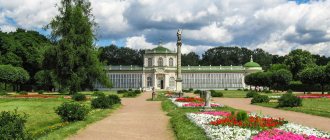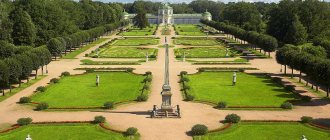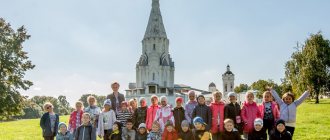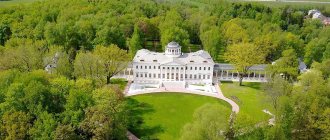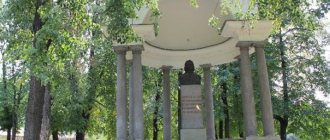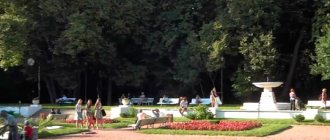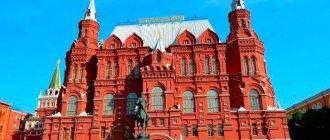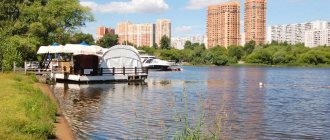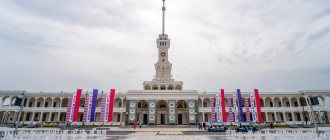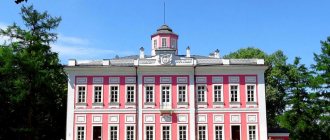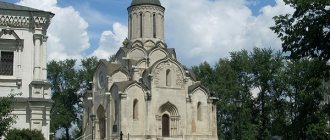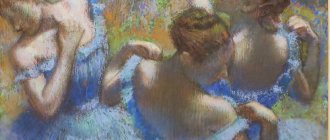Russia, like any other country, is famous for its sights, architectural monuments and unique palace and park ensembles. One of them is the Kuskovo Museum.
In this place, human destinies, rich collections of exhibits, as well as historical events are harmoniously intertwined. Originally existing as a separate settlement, in the course of history Kuskovo turns into a memorial complex, and then takes the Porcelain Museum under its auspices.
Read about other estate museums in Moscow here.
Kuskovo Estate Museum. Source: strana.ru
Kuskovo Estate - how to get there
The Kuskovo estate is located in the east of Moscow in the Vishnyaki district. The easiest way to get to the estate is by metro.
- Metro Ryazansky Prospekt . Buses No. 133 and No. 208 go directly from the metro to the Kuskovo Museum .
- Metro station Vykhino . Bus No. 620 will take you to the Kuskovo Museum stop.
- Metro Novogireevo . From the metro, take trolleybus No. 77 , bus No. 64 and many minibuses to the Yunosti Street stop, from where you will have to walk about 600 meters to the entrance to Kuskovo Park.
The easiest option is to get to the Kuskovo estate from the Ryazansky Prospekt metro station; there are more buses here and the journey is short. The opening hours of the Kuskovo Museum can be checked at the Kuskovo Estate Museum of the Kuskovo Museum, but remember that the museum is closed on Mondays and Tuesdays.
Poultry yard
Well, since we are exploring the economic objects of the Kuskovo estate today, we can’t help but look into the Aviary.
In summer, bird life is in full swing there. Peacocks, guinea fowl and God knows what other exotic birds stroll around.
We liked one peacock so much that we gave him a name - Dmitry Donskoy. Don't ask why, we don't know.
These, of course, are not all the significant objects that can be seen at the Kuskovo estate.
Left behind the scenes are the Italian and Swiss houses, the Kitchen outbuilding, the Air Theater, etc.
But maybe that's a good thing? In any case, there will be a reason to come here again!
See you again!
Kuskovo Estate
Once you enter the park, you immediately feel as if you have stepped into the past with the help of a time machine. You immediately imagine how noble people are strolling along this very linden alley, ladies are walking with dogs, and gentlemen are galloping on horses.
The first question that comes to mind when mentioning Kuskovo is related to the name. Why Kuskovo? Everything is very prosaic. The first mention of Kuskovo dates back to 1623; until that moment, Count Boris Petrovich Sheremetev owned only one small plot, the count himself called it a “piece,” while the rest of the lands belonged to Alexei Mikhailovich Cherkassky, the future state chancellor. Count Sheremetev became related to him by marrying his son to the chancellor’s daughter. After this, the Sheremetevs became the sole owners of Kuskovo, but the name remained.
The palace appeared here much later, only in 1774. An interesting fact is that serf architects Fyodor Argunov and Alexey Mironov worked on the entire architectural ensemble of the estate.
In front of the palace lies the Great Palace Pond, and behind the pond the territory of the Kuskovo Dam Park is visible.
Entrance to the palace is paid; at the entrance to the territory of the Kuskovo Museum we bought a comprehensive ticket, which includes a visit to all pavilions of the estate and the palace.
The exposition of the palace is the interiors. You can admire for a long time the beauty of the interiors and the uniqueness of the construction and arrangement of the rooms. The rooms go one after another, the doors in them are made on the same axis, so the exit from the previous room is the entrance to the next. The rooms themselves are located opposite the window, thus letting in the maximum amount of light into the room.
The “Big House,” as the palace was called in the 18th century, was built in the classicist style. It was the pleasure residence of Count Pyotr Borisovich Sheremetev.
The Sheremetev Palace is one of the few architectural heritages in which everything has been preserved in its original form, right down to the plank floors, fireplaces and stoves.
A walk through the palace takes us to a large hall, intended for ceremonies and balls, from here symmetrical entrance doors lead us out of the palace into Kuskovo Park.
Hermitage
The Hermitage pavilion lurks in the middle of the alleys of the regular park.
Ermitage in French is a hermit's hut. The building was built in 1765-67 by architect K.I. In blank form.
Not a single rich regular park of that time could do without such a pavilion. Remember, for example, Peterhof.
This “modest house” was intended for secret meetings, dates, and entertainment among selected friends.
The building was equipped with everything necessary for meals. It was even possible to do without the help of the ever-gossiping servants; dishes were served using special mechanisms.
Kuskovo Estate Park
Symmetry, which always distinguishes buildings of the 18th century, is here the main element of the architectural style and opposite the main palace at the other end of the park we see the building of a large stone greenhouse.
The view is covered by an obelisk erected in the park at the end of the 18th century in honor of Empress Catherine II’s visit to the estate.
You can walk around the park itself much longer than around the palace; of course, it will be difficult to get lost, but it will take some time to figure out the directions, especially since symmetry here laughs and plays with the visitor, confusing him.
We started our exploration of the park from the Dutch House.
The house is called Dutch because of the motifs that were central to the construction of the structure. The house was built in the Dutch style of the 17th century, and the interiors are also designed in the Dutch style. True, one can notice Russian redundancy here. The tiles that the Dutch used to decorate their houses were very expensive, so they were used to a minimum in decoration, only to emphasize the beauty of the interior. Here the kitchen is entirely tiled, as a sign of the high cost of finishing.
In the same part of the park as the Dutch house there is the Hermitage pavilion. The pavilion has been restored, but we were not able to visit it, it was temporarily closed. It houses an exhibition of porcelain.
So, walking through the park, we came to the Big Stone Greenhouse.
The greenhouse houses two exhibitions at once. The first is a portrait exhibition of all representatives of the Sheremetev dynasty, the second is an exhibition of ceramics and porcelain. The greenhouse offers a beautiful view of the main palace.
In another part of the park there is an American greenhouse, which also houses a collection of porcelain and an aviary for birds. Both buildings are modern reconstructions.
The park of the Kuskovo Museum is very beautiful and diverse. In addition to the pavilions themselves, it is decorated with numerous marble statues, trimmed hedges and covered walkways.
Museum today
Currently, Kuskovo is a rich monument to the history and culture of the Russian people. Visitors can see its exhibitions of the palace and park ensemble, exhibitions of porcelain, ceramics and glass.
The Kuskovo Forest Park has been added to the list of specially protected natural areas in Moscow. According to current legislation, this place has special cultural, aesthetic and recreational significance. It is completely withdrawn from economic use and is protected by the state.
The museum served as a film set for some works of Russian cinema. It was also the setting for dozens of historical television series and video clips.
The reserve annually hosts the festival “Organ Evenings in Kuskovo”. It covers a cycle of concert works and compositions. Outstanding domestic performers and groups take part in their performance.
When visiting this event, everyone can enjoy masterpieces of organ music.
Pavilion Grotto, Kuskovo Estate
So we got to the most beautiful of the pavilions. The Grotto Pavilion was built in the Baroque style and is the only pavilion in Russia that has retained its original “grotto” decoration of the premises.
The interior is decorated with glass and limestone, thus creating the atmosphere of a real grotto, embodying the combination of the elements of stone and water. Behind the Grotto pavilion there is a fish pond and Menagerie, although this is also a modern reconstruction.
Not far from the Grotto pavilion is an Italian house.
So we again reached the main palace and the buildings located nearby. Such as the kitchen outbuilding.
There is also a church next to the palace, but at the time of visiting the estate it was under reconstruction, so there was nothing to photograph nearby. In the photo she is to the right of the palace.
Story
The first mentions of the estate date back to the 16th century. For about four hundred years, until 1917, the estate belonged to the Sheremetev family. At the beginning of the 17th century there was a wooden church and a boyar's courtyard. The estate flourished in the 18th century, when it was owned by Pyotr Borisovich Sheremetev, the son of the famous Field Marshal B.P. Sheremetev, hero of the Battle of Poltava. Starting from the mid-18th century, a beautiful ensemble was created with a palace, a large park and ponds. Magnificent receptions of guests were held here, sometimes attended by up to 30 thousand people. For fun, pavilions and gazebos, a greenhouse and a cabinet of curiosities, a menagerie and a hunting lodge were built. The last owner of the ensemble until 1917 was Sergei Dmitrievich Sheremetev. After the revolution, the estate was nationalized. In 1919 it became the State Museum. Since 1938, the museum was merged with the only ceramics museum in Russia.
Praskovya Zhemchugova
There is another exhibition in the palace building. The entrance to it is located at the end of the palace, the staircase takes us to the second floor and immerses us in the amazing life of one simple young lady, or rather a peasant woman who became a young lady - Praskovya Zhemchugova.
Praskovya was born into the family of the serf blacksmith Kovalev. Along with other serfs, she was given to Peter Sheremetev as a dowry from his wife Varvara Cherkasskaya. At the age of seven, Praskovya Kovaleva was taken into care in Kuskovo by Countess Marfa Mikhailovna, then married to Princess Dolgorukaya. The girl early discovered a talent for music and began to prepare her for the estate’s theater troupe, in which she achieved amazing success, impressing Empress Catherine II during her visit to Kuskovo, and receiving a diamond ring from her. During her performances, Praskovya acquired a stage name and became Zhemchugova.
The heir of Pyotr Borisovich Sheremetev, Nikolai, was captivated by the beauty of Praskovya. But the count's origins forbade him to connect his fate with a serf girl. In 1797, Emperor Paul I granted Count Nikolai Petrovich the title of Chief Marshal, which obliges him to stay in St. Petersburg. Nikolai leaves there, taking Praskovya with him. But in St. Petersburg, her tuberculosis worsens due to the damp metropolitan climate. Under Paul I, Nicholas again did not dare to formalize his relationship with Praskovya. A year later, he gives freedom to her entire family, and only in 1801, with the permission of Emperor Alexander I, he marries Praskovya Zhemchugova. In 1803, they had a son, Dmitry, who would become the only heir of the Sheremetev family. Three weeks after giving birth, Praskovya Sheremeteva passes away at the age of 35. This story excited the minds and feelings of their contemporaries and excites the feelings of everyone who just gets acquainted with it.
Places like the Kuskovo estate should be visited not only to have a good and useful day, here you can also learn to love the history of the whole state and its individual members. Or if you have already developed a love for history, then learn something new for yourself and visit the places where historical figures lived. The Kuskovo Estate Museum is exactly the place where history is intertwined, where you can travel back two hundred years and walk along those corridors and alleys where the Sheremetev counts and countesses walked.
American sister
The Great Stone Greenhouse has a sister - the American Greenhouse.
This building, stylish from the point of view of architectural merits, has, oddly enough, a purely utilitarian function.
The angle of inclination of the roofs and window frames - standing and recumbent - was ideally calculated to provide different heat and light conditions for different types of tropical plants.
Thanks to this “individual approach to the client,” many capricious guests from different continents lived peacefully here - orchids, oranges, coffee trees, palm trees, pineapples, peach trees, and entire families of cacti.
To maximize the absorption of sunlight in the American Greenhouse, glass of a greenish tint was used.
Be sure to stop by the back patio of this greenhouse. There is a cozy house with a garden there.
You can just imagine how modestly and simply the gardener’s family lived here.
